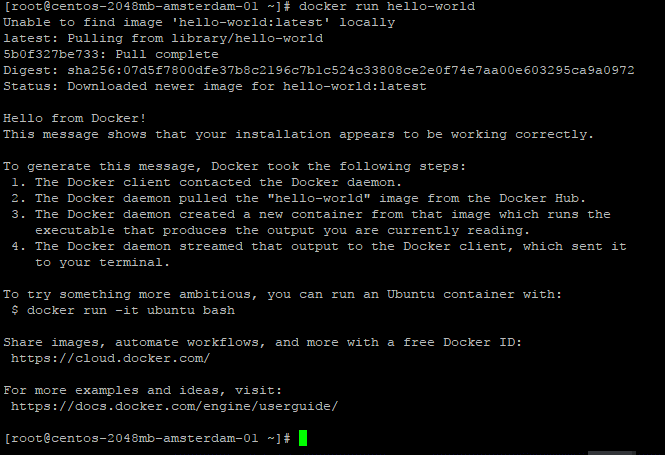Setting up a Docker instance on your CentOS 7.4 VPS
Introduction
Docker is considered to be a modern container-based technology, that utilizes a cgroups and namespaces Linux technology. In fact, it's not a virtualization technology, but a software to add an additional isolated layer inside the host OS. You can run multiple instances of such containers, each container fullfilling it's own role. It has a lot of features, that make deploy, installation, migration and maintenance of your application a much easier process. In this guide i will describe how to install docker on your VPS, how to pull an image with a specific application inside and check that it performs as expected.
Preprequisites
1) Centos 7.4 VPS instance 2) Basic Linux skills ( package installation, file editing, service control )
Installation
There are two branches of Docker: Enterpise Edition ( paid edition ) and Community Edition. For development purposes, and most cases, Community Edition is good enough, however if you consider using docker in high-scale commercial production environment, and require support, consider using Enterprise Edition.
There are also two ways of obtaning docker: Centos official repository and upstream official repository. I prefer, and recommend to use upstream repository, since it is up to date, in sync and generally maintained well.
I will describe a process of installation a Community Edition docker from upstream official repository.
https://store.docker.com/editions/community/docker-ce-server-centos[1]
1) Confirm that you do not have any old docker version
run rpm -qa |grep docker
and confirm that you have no other docker packages installed, for example from Centos repository.
If you have them, and do not know where did you get them from, you have never installed them, and you know that you do not user docker remove them with
yum remove <docker package names>
If you share VPS server with someone, and it may be used by someone, better consult with them, to ensure you do not remove someone's valuable work :)
2) setup an upstream docker repository
run wget -O /etc/yum.repos.d/docker-ce.repo https://download.docker.com/linux/centos/docker-ce.repo
confirm that repo was added properly
yum repolist
your output should show new docker-ce repository

3) install docker-ce package
yum install docker-ce
4) start the docker process and confirm that it have started without a problem
systemctl start docker
systemctl status docker
Status should display no error

5) Confirm that your docker installation works, as expected
run docker run hello-world
You should get a similar output, that speaks for itself

6) Pull a container image, that you will use to expriment
By default docker hub includes a lot of different images, some of them contain a system with some application deployed, some are just some system images.
docker allows to search for images using special coommand docker search
Just add a search argument, for example docker search ansible or docker search centos and check the output.
Let's pull the ubuntu image with sshd service
docker search sshd
 Let's pull the top rated image
Let's pull the top rated image
docker pull rastasheep/ubuntu-sshd

Check that image is now available locally
docker images

Here is info about this container: https://github.com/rastasheep/ubuntu-sshd[2]
PermitRootLogin yes
UsePAM no
exposed port 22
default command: /usr/sbin/sshd -D
root password: root
7) Let's start this container and check that it is available
docker run -d -P --name ssh_test rastasheep/ubuntu-sshd
Check what host port is forwarded to 22 port inside the container
docker port ssh_test 22
 And now try connecting to this instance from a remote pc and check that is is really ubuntu
And now try connecting to this instance from a remote pc and check that is is really ubuntu
 We clearly see that we can connect to our docker instance from the external machine, and that it is running ubuntu inside.
We clearly see that we can connect to our docker instance from the external machine, and that it is running ubuntu inside.
Conclusion
You now know how to install Docker on your VPS server and a basic docker container scenario usage. In our case you have an isolated instance inside our VPS server, that can be used for different purposes. This is only a glimpse into all the features that Docker provides, however you now have a good base to start dockerising your applications or services.
[1]: https://hub.docker.com/editions/community/docker-ce-server-centos
[2]: https://github.com/rastasheep/ubuntu-sshd






